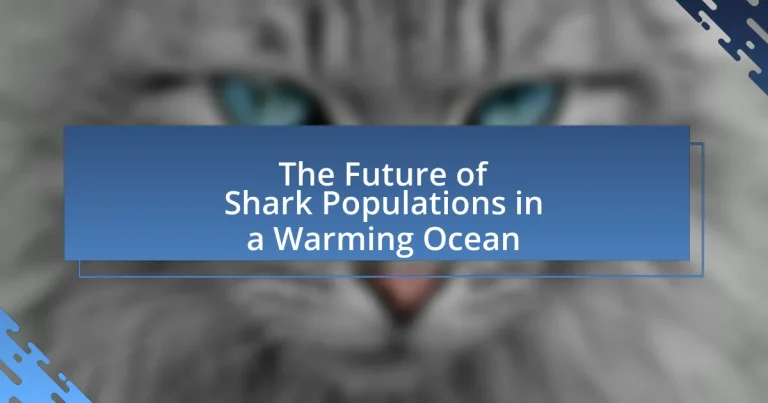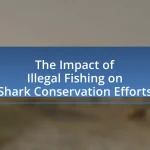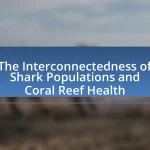The article focuses on the future of shark populations in a warming ocean, highlighting the significant decline in these populations due to climate change, overfishing, and habitat loss. It discusses how rising ocean temperatures affect shark distribution and reproductive success, leading to ecological imbalances in marine ecosystems. The article also examines the impact of human activities, such as pollution and unsustainable fishing practices, on shark survival. Furthermore, it outlines conservation efforts, including marine protected areas and international regulations, aimed at safeguarding shark populations and maintaining ocean health.
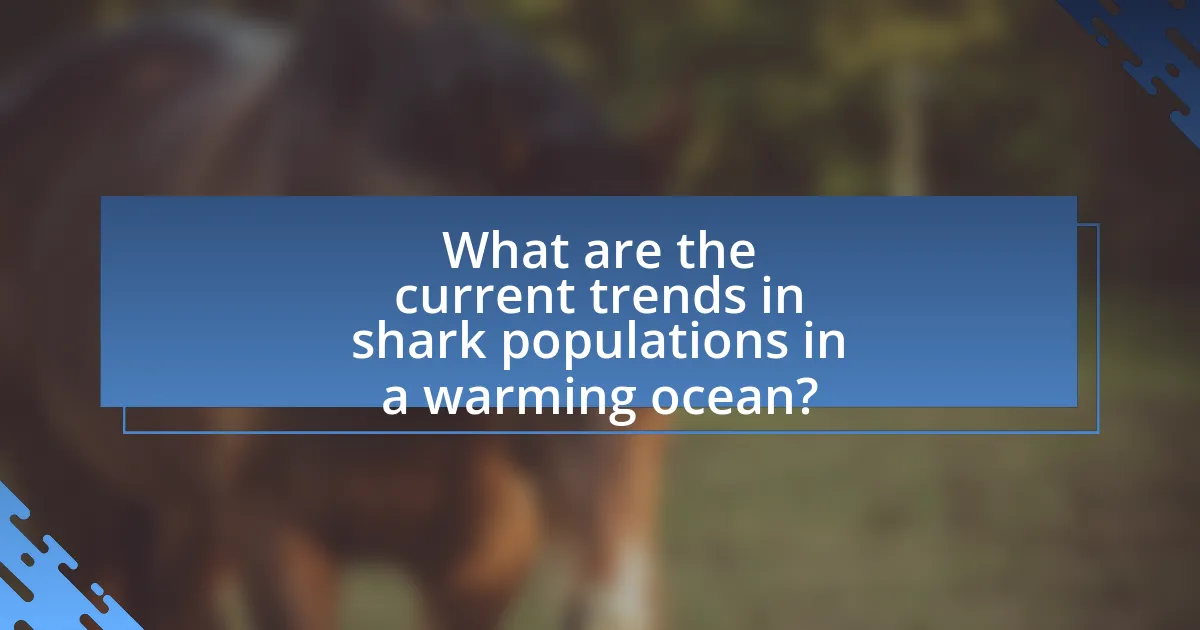
What are the current trends in shark populations in a warming ocean?
Current trends indicate that shark populations are declining in a warming ocean due to habitat loss, overfishing, and changing prey availability. Research shows that rising sea temperatures affect shark distribution, leading to shifts in their habitats towards cooler waters, which can disrupt local ecosystems. For instance, a study published in the journal “Global Change Biology” by Cheung et al. (2016) highlights that many shark species are experiencing range contractions and population decreases as their preferred environments become less suitable. Additionally, increased ocean temperatures can impact the reproductive success of sharks, further contributing to their decline.
How does climate change impact shark habitats?
Climate change significantly impacts shark habitats by altering ocean temperatures, salinity, and prey availability. Warmer waters can lead to shifts in shark distribution, as species migrate towards cooler areas, often resulting in habitat loss in their traditional ranges. Additionally, ocean acidification, a consequence of increased carbon dioxide levels, affects the ecosystems that sharks rely on for food, such as fish and marine invertebrates. Research indicates that species like the great white shark are already showing changes in migratory patterns due to rising sea temperatures, which can disrupt breeding and feeding grounds. These changes threaten the stability of shark populations and the overall health of marine ecosystems.
What specific changes in ocean temperature affect shark distribution?
Specific changes in ocean temperature that affect shark distribution include increases in sea surface temperatures and alterations in thermal stratification. Sharks are ectothermic animals, meaning their body temperature is influenced by the surrounding water. As ocean temperatures rise, many shark species migrate towards cooler waters, often moving poleward or to deeper regions. For instance, studies have shown that species like the great white shark have shifted their range northward in response to rising temperatures, with a documented increase in sightings along the northeastern coast of the United States. Additionally, changes in thermal stratification can impact prey availability, further influencing shark distribution patterns. Research indicates that warmer waters can lead to shifts in the distribution of key prey species, such as fish and squid, which in turn affects where sharks are found.
How do altered ocean currents influence shark migration patterns?
Altered ocean currents significantly influence shark migration patterns by changing the distribution of prey and altering environmental conditions. Sharks rely on specific temperature ranges and prey availability, which are affected by ocean currents. For instance, warmer currents can lead to shifts in the locations of nutrient-rich waters, impacting the abundance and distribution of prey species like fish and squid. Research indicates that species such as the great white shark have been observed migrating to areas with altered currents that provide optimal hunting conditions, demonstrating a direct correlation between current changes and migration behavior.
What are the implications of declining shark populations?
Declining shark populations lead to significant ecological imbalances in marine ecosystems. Sharks are apex predators, and their reduction disrupts the food chain, resulting in overpopulation of prey species, which can cause further degradation of marine habitats. For instance, studies show that the decline of shark populations can lead to an increase in smaller fish species, which may overgraze on seagrass and coral reefs, ultimately harming biodiversity and ecosystem health. Additionally, the loss of sharks can affect fisheries, as their presence helps maintain the balance of fish populations, which is crucial for sustainable fishing practices.
How does the decline of sharks affect marine ecosystems?
The decline of sharks significantly disrupts marine ecosystems by leading to an imbalance in species populations. Sharks are apex predators, and their reduction allows prey species, such as smaller fish and invertebrates, to proliferate unchecked. This overpopulation can result in the depletion of essential marine vegetation, such as seagrasses and coral reefs, which rely on a balanced ecosystem to thrive. Research indicates that the loss of sharks can lead to a 50% decline in the diversity of marine species, as documented in a study published in the journal “Ecology Letters” by Ferretti et al. (2010). This imbalance not only affects biodiversity but also compromises the health of marine habitats, ultimately impacting fisheries and human communities that depend on these ecosystems for their livelihoods.
What role do sharks play in maintaining ocean health?
Sharks play a crucial role in maintaining ocean health by acting as apex predators that help regulate marine ecosystems. Their presence controls the population of prey species, which in turn maintains the balance of the entire food web. For example, studies have shown that the decline of shark populations can lead to an overabundance of smaller fish and invertebrates, resulting in the degradation of coral reefs and other habitats. Research published in the journal “Nature” indicates that healthy shark populations contribute to biodiversity and the resilience of marine ecosystems, highlighting their importance in sustaining ocean health.

What factors contribute to the future of shark populations?
The future of shark populations is primarily influenced by climate change, overfishing, habitat loss, and pollution. Climate change alters ocean temperatures and currents, affecting shark migration patterns and breeding grounds. Overfishing depletes shark numbers, with studies indicating that some species have declined by over 90% due to unsustainable fishing practices. Habitat loss, particularly from coastal development and degradation of marine ecosystems, further threatens their survival. Pollution, including plastic waste and chemical runoff, impacts shark health and reproductive success. Collectively, these factors create a precarious future for shark populations, necessitating immediate conservation efforts to mitigate their decline.
How do human activities impact shark survival?
Human activities significantly threaten shark survival through overfishing, habitat destruction, and pollution. Overfishing, particularly through practices like shark finning and bycatch, has led to dramatic declines in shark populations; for instance, global shark populations have decreased by over 70% in the last 50 years due to unsustainable fishing practices. Habitat destruction, such as coastal development and mangrove deforestation, reduces essential breeding and nursery areas for sharks, further jeopardizing their survival. Additionally, pollution, including plastic waste and chemical runoff, contaminates marine environments, harming sharks directly and disrupting their food sources. These factors collectively contribute to the decline of shark populations, underscoring the urgent need for conservation efforts.
What is the effect of overfishing on shark numbers?
Overfishing significantly reduces shark numbers, leading to population declines and potential extinction of certain species. Research indicates that overfishing has caused a decrease in global shark populations by up to 70% in some regions, disrupting marine ecosystems and food chains. For instance, a study published in the journal “Marine Policy” by Dulvy et al. (2014) highlights that overfishing is a primary driver of the decline in shark populations, emphasizing the urgent need for sustainable fishing practices to protect these vital marine predators.
How does pollution affect shark health and reproduction?
Pollution negatively impacts shark health and reproduction by introducing harmful chemicals and toxins into their environments. These pollutants, such as heavy metals and persistent organic pollutants, can accumulate in shark tissues, leading to compromised immune systems, increased susceptibility to diseases, and reproductive issues. For instance, studies have shown that exposure to polychlorinated biphenyls (PCBs) can disrupt endocrine functions in sharks, affecting their reproductive capabilities and leading to lower birth rates. Additionally, the presence of microplastics in marine ecosystems can cause physical harm and reduce the availability of prey, further stressing shark populations.
What conservation efforts are being implemented to protect sharks?
Conservation efforts to protect sharks include the establishment of marine protected areas (MPAs), regulations on shark fishing, and international agreements such as the Convention on International Trade in Endangered Species (CITES). MPAs restrict human activities in designated areas, allowing shark populations to recover; for example, the Bahamas has implemented a nationwide shark sanctuary. Regulations on fishing, such as catch limits and bans on shark finning, aim to reduce overfishing and bycatch. CITES provides a framework for regulating trade in endangered shark species, ensuring that their populations are not threatened by international commerce. These efforts are supported by scientific research indicating that effective management can lead to population recovery and ecosystem health.
What role do marine protected areas play in shark conservation?
Marine protected areas (MPAs) play a crucial role in shark conservation by providing safe habitats that reduce human impacts such as overfishing and habitat degradation. These designated zones allow shark populations to recover and thrive, as they limit activities like fishing and coastal development that can harm their ecosystems. Research indicates that MPAs can lead to increased shark abundance and diversity; for instance, a study published in the journal “Conservation Biology” found that shark populations in protected areas were up to three times more abundant than in unprotected areas. This evidence underscores the effectiveness of MPAs in fostering healthier marine environments, which are essential for the long-term survival of shark species in a warming ocean.
How effective are international regulations in safeguarding shark populations?
International regulations are moderately effective in safeguarding shark populations, but their success varies by region and enforcement. For instance, the Convention on International Trade in Endangered Species (CITES) has listed several shark species, which helps regulate trade and reduce overfishing. However, compliance and enforcement remain significant challenges, as many countries lack the resources or political will to implement these regulations effectively. According to a study published in the journal “Marine Policy,” only 30% of countries fully comply with CITES regulations for sharks, indicating gaps in protection. Additionally, regional fisheries management organizations (RFMOs) have established measures for some shark species, but inconsistent application and monitoring hinder their effectiveness. Overall, while international regulations provide a framework for shark conservation, their impact is limited by enforcement issues and varying levels of commitment among nations.
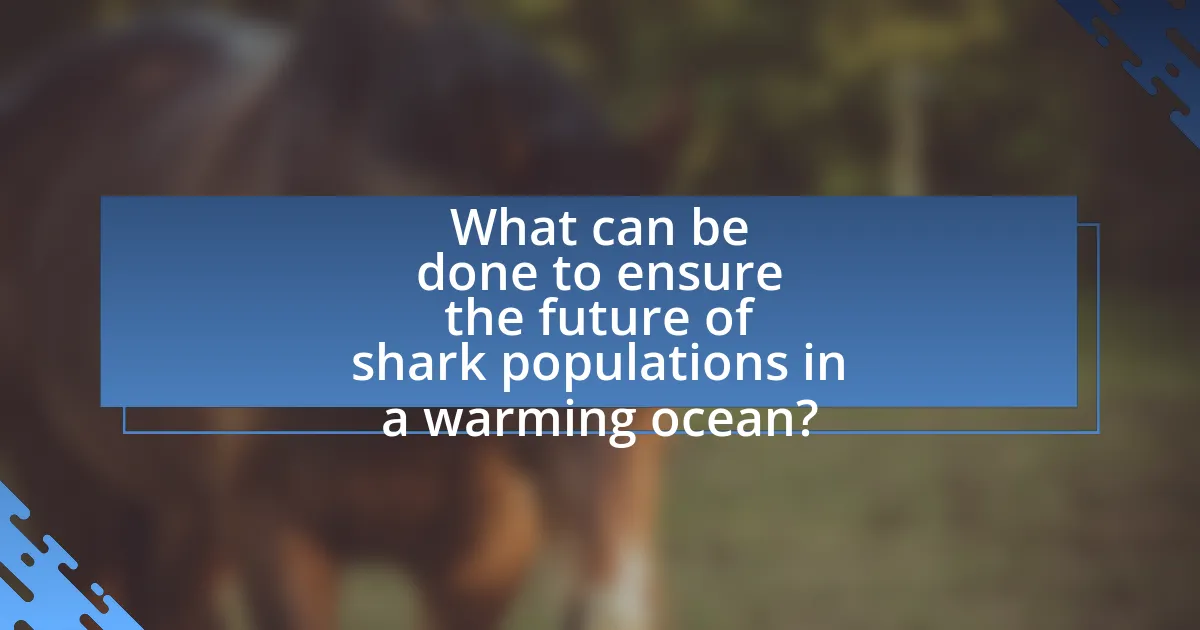
What can be done to ensure the future of shark populations in a warming ocean?
To ensure the future of shark populations in a warming ocean, effective conservation strategies must be implemented, including the establishment of marine protected areas (MPAs) and sustainable fishing practices. MPAs can provide safe habitats for sharks, allowing populations to recover and thrive, as evidenced by studies showing that protected areas can lead to increased biodiversity and fish biomass. Additionally, sustainable fishing practices, such as catch limits and bycatch reduction techniques, are essential to prevent overfishing and ensure that shark populations remain stable. Research indicates that regions with strict fishing regulations have seen significant increases in shark numbers, highlighting the importance of these measures in safeguarding their future in changing ocean conditions.
How can individuals contribute to shark conservation efforts?
Individuals can contribute to shark conservation efforts by supporting sustainable seafood choices, advocating for marine protected areas, and participating in citizen science initiatives. Sustainable seafood choices help reduce overfishing, which is a significant threat to shark populations; for instance, the Marine Stewardship Council reports that sustainable fishing practices can help maintain healthy marine ecosystems. Advocating for marine protected areas can safeguard critical habitats for sharks, as studies show that such areas can lead to increased shark populations and biodiversity. Additionally, participating in citizen science initiatives, such as shark monitoring programs, allows individuals to contribute valuable data that can inform conservation strategies, as evidenced by projects like the Shark Trust’s citizen science programs that engage the public in data collection and awareness efforts.
What practices can promote sustainable fishing?
Sustainable fishing can be promoted through practices such as implementing catch limits, using selective fishing gear, and establishing marine protected areas. Catch limits help prevent overfishing by ensuring that fish populations remain at sustainable levels, as evidenced by studies showing that well-managed fisheries can recover and thrive. Selective fishing gear reduces bycatch, which is the capture of unintended species, thereby protecting vulnerable populations, including sharks. Marine protected areas provide safe habitats where fish can reproduce and grow, contributing to the overall health of marine ecosystems. These practices collectively support the sustainability of fish populations and the marine environment.
How can public awareness campaigns help protect sharks?
Public awareness campaigns can help protect sharks by educating the public about their ecological importance and the threats they face. These campaigns raise awareness about issues such as overfishing, habitat destruction, and the impact of climate change on shark populations. For instance, studies have shown that increased public knowledge can lead to greater support for conservation measures, such as marine protected areas, which are essential for the survival of shark species. Additionally, campaigns can promote responsible tourism and fishing practices, reducing harmful interactions with sharks. Evidence from successful campaigns indicates that informed communities are more likely to advocate for policies that protect marine ecosystems, ultimately contributing to the sustainability of shark populations in a warming ocean.
What are the best practices for researchers studying shark populations?
The best practices for researchers studying shark populations include employing standardized survey methods, utilizing advanced tracking technologies, and ensuring collaboration with local communities. Standardized survey methods, such as visual surveys and catch-and-release techniques, provide consistent data for population assessments. Advanced tracking technologies, like satellite and acoustic tagging, allow researchers to monitor shark movements and behaviors in real-time, enhancing understanding of their ecology. Collaboration with local communities fosters knowledge sharing and promotes conservation efforts, as local stakeholders often possess valuable insights into shark behavior and habitat use. These practices are supported by studies indicating that effective monitoring and community engagement significantly improve conservation outcomes for shark populations.
How can technology improve monitoring of shark populations?
Technology can improve monitoring of shark populations through the use of advanced tracking devices, such as satellite tags and acoustic transmitters. These devices provide real-time data on shark movements, behavior, and habitat use, allowing researchers to gather precise information on population dynamics. For instance, a study published in the journal “Marine Ecology Progress Series” demonstrated that satellite tagging can track the migratory patterns of species like the great white shark, revealing critical insights into their breeding and feeding grounds. Additionally, the integration of drones and underwater robots enhances data collection by enabling researchers to survey large areas of ocean efficiently, further contributing to the understanding of shark populations in changing marine environments.
What collaborative efforts are essential for effective shark conservation?
Effective shark conservation requires collaborative efforts among governments, NGOs, scientists, and local communities. These stakeholders must work together to establish and enforce protective regulations, such as fishing quotas and marine protected areas, which are crucial for sustaining shark populations. For instance, the Convention on International Trade in Endangered Species (CITES) has facilitated international cooperation to regulate trade in shark species, demonstrating the importance of global agreements in conservation efforts. Additionally, community engagement in conservation initiatives, such as local monitoring programs, has proven effective in promoting sustainable practices and raising awareness about the ecological role of sharks. Collaborative research initiatives, like those conducted by the Shark Research Institute, further enhance understanding of shark behavior and population dynamics, informing better management strategies.
